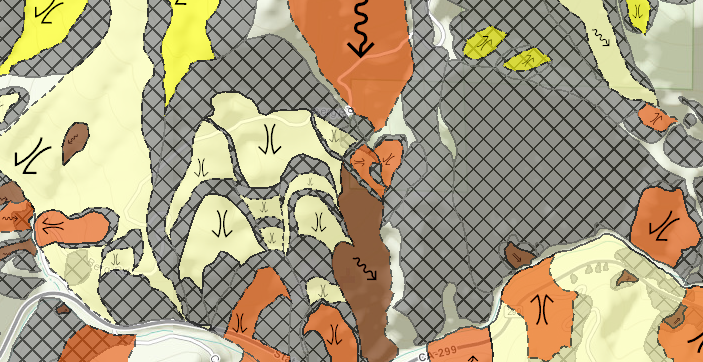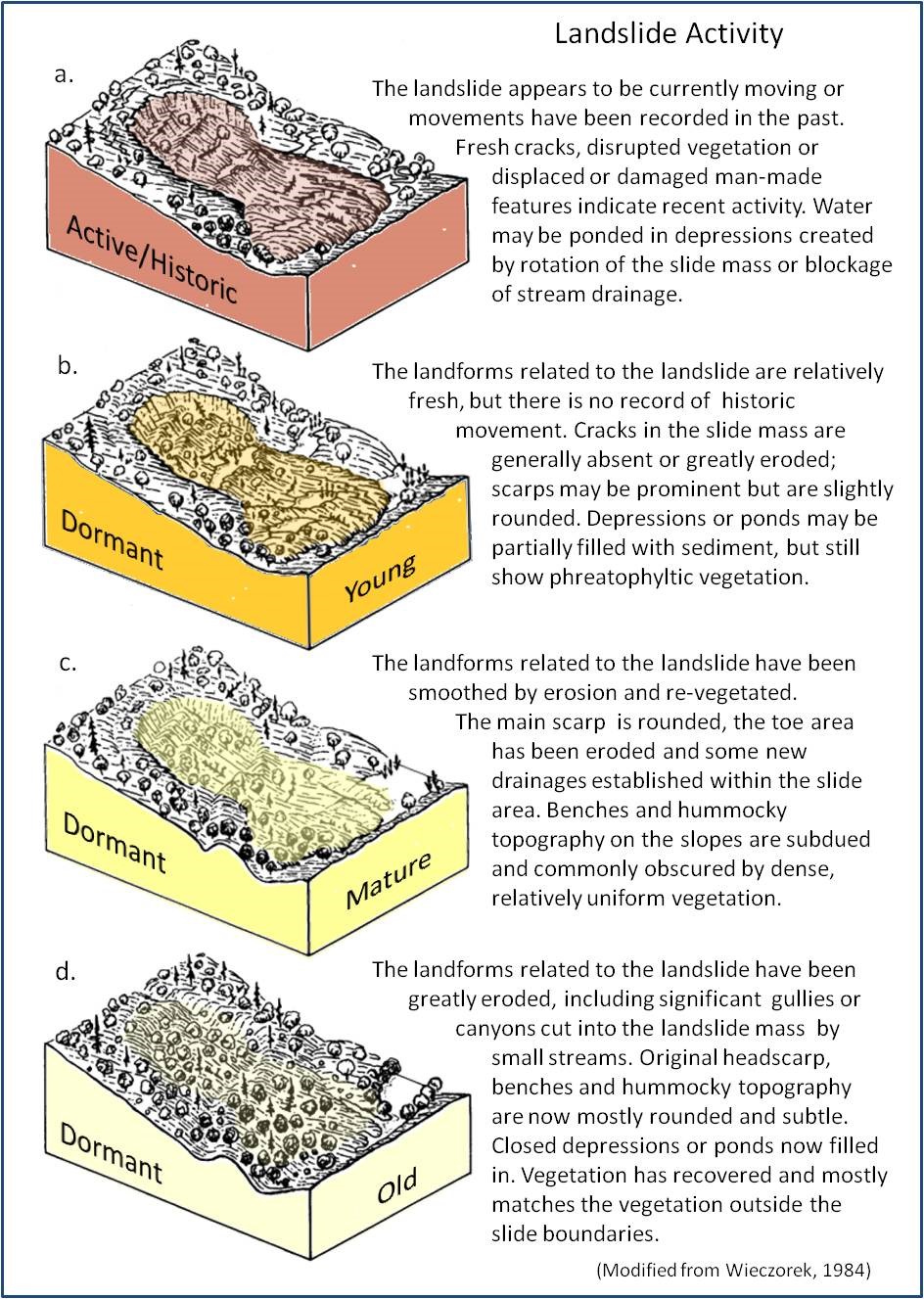 Landslide symbols on a map.
Landslide symbols on a map.
Since the 1960’s, the California Geological Survey (CGS) has produced numerous maps that show landslide features and delineate potential slope-stability problem areas. Preparation of these maps has been episodic, often driven by landslide disasters and subsequent legislative mandates. Many CGS landslide maps and related products have been produced for local or state agencies in response to their specific needs.
To find the landslide map that covers your area of interest, please see our
Landslide Map Index
. Refer to the explanation on that map and descriptions of the types of landslides and types of landslide maps for details on how landslides are mapped and described.
Types of Landslide Maps
Four principal types of information describing the various classes of landslides are portrayed by different landslide maps prepared by the California Geological Survey: (1) inventories of existing landslides, (2) landslide hazard—expressed as landslide susceptibility or landslide potential maps, (3) landslide risk maps, and (4) landslide zone maps. The maps can be either qualitative or quantitative in their preparation.
-
Landslide-inventory maps, the most basic landslide maps, portray the location of prior failure. Because one clue to the location of future landsliding is the distribution of past movement, maps that show existing landslides are helpful in predicting the hazard. Inventory maps do not necessarily distinguish fresh movements, but in any one year some of the mapped slides—or more frequently, portions of them—may become active. A landslide inventory reveals the extent of past movement and thus the probable locus of some future activity within those landslides, but it does not indicate the likelihood of failure for the much larger area between mapped landslides. For this, hazard, risk or zone maps are required.
-
Landslide-hazard mapsdescribe an unstable condition arising from the presence or likely future occurrence of slope failure. There are two general types of landslide-hazard maps, each of which provides a different level of information and detail:
-
Landslide-susceptibility mapsdescribe the relative likelihood of future landsliding based solely on the intrinsic properties of a locale or site. Prior failure (from a landslide inventory), rock or soil strength, and steepness of slope are the three site factors that most determine susceptibility.
-
Landslide-potential mapsdescribe the likelihood of landsliding (susceptibility) jointly with the occurrence of a triggering event (opportunity). Potential commonly is based on the three factors determining susceptibility plus an estimate or measure of the probability (likelihood of occurrence) of a triggering event such as earthquake or excessive rainfall.
-
Landslide-risk mapsdescribe landslide potential jointly with the expected losses to life and property if a failure was to occur. The potential for landslide damage to a road system, for example, can be evaluated by considering the exposure of the roads to different levels of landslide hazard and the vulnerability of the roads to consequent damage. Similarly, the risk of excessive sedimentation in streams and other ecological damage can be evaluated by considering the landslide hazard jointly with the properties of streams and their sensitivity.
-
Landslide-zone mapsdepict areas with a higher probability of landsliding, within which specific actions are mandated by California law prior to any development. These maps typically are binary in nature (a given site is either in or out of the zone) and are designed for use as planning tools by non-geoscientists. Zone maps may be derived from landslide potential or susceptibility, but some have been based simply on slope gradient or landslide-inventory maps.
Landslide hazard, risk and zone maps are prepared in many ways, increasingly involving complex manipulations of multiple criteria by computer. Because the value of landslide maps can be judged only by whether they correctly predict the locations of future failures, effectiveness of the different approaches to constructing them is difficult to evaluate.
Categories of Landslide Activity
 Categories of landslide activity. Click the image to open a larger version in a new window.
Categories of landslide activity. Click the image to open a larger version in a new window.
Each landslide is classified based on the recency of activity into one of four categories based on the system of Keaton and DeGraff, (1996). The landslide activity categories are graphically portrayed with the colors used to delineate landslide activity on the maps. The designation of activity shows an estimate of how recently the landslide moved, but also suggests the type of hazard represented. More recently active landslides are more likely to continue to fail, or to fail completely. Older landslides are less likely to move as single slide masses, but may be the source of smaller slides.
Confidence of Interpretation
Each landslide is classified according to a "confidence" that the geologic interpreter assigns to it, and can be regarded as a measure of the likelihood that the landslide actually exists. Landslides are mapped on the basis of characteristic landforms, and the confidence of interpretation is based on the distinctness of those landforms. As a landslide ages after its last movement, erosional processes remove or cover the landforms that formed by landsliding. With time, these distinctive landforms become so subtle that they resemble landforms produced by geologic processes and conditions unrelated to landsliding. The confidence of interpretation is depicted on a map by the use of different line styles (solid, dash, and dot).

Definite: Landslide exhibits many of the diagnostic landforms, including, but not limited to, prominent scarps, open cracks, rounded toes, offset streams, well-defined mid-slope benches, closed depressions, springs, and irregular or hummocky topography; or has clear records of prehistoric, historic or ongoing activity from reports, aerial photography or instrumental monitoring.

Probable: Landslide exhibits several of the diagnostic landforms commonly associated with landslides. These landforms may be modified by erosion or obscured by vegetation such that other explanations are possible. However, the preponderance of evidence strongly suggests that a landslide does exist.

Questionable: Landslide exhibits only one or a few of the diagnostic landforms associated with landslides. The landforms may be heavily modified by erosion, altered by grading, obscured by dense vegetation, or formed by other geologic processes such as differential erosion of lithologic and structural features in the underlying bedrock.
Translation of landslides from some legacy maps requires a geologist to interpret the original author's confidence from the graphics on those maps. Most commonly, older maps have two types of symbols indicating confidence: a landslide polygon is either shown with a query or with arrows indicating direction of movement. Where CGS compiled older mapping for this project, we reviewed aerial photos and discussed procedures with the original authors, if possible. Based on this review we have classified landslide areas shown with a query as "questionable" and others as "definite".
Cited References
Cruden, D.M., and Varnes, D.L. 1996, Chapter 3: Landslide types and processes, pp. 36-75 in A.K. Turner and R.I. Schuster (eds.), Landslides: Investigation and Mitigation, Special Report 247, Transportation Research Board, National Research Council, Washington D.C.: National Academy Press.
Keaton, J.R., and DeGraff, J.V., 1996, Surface observation and geologic mapping, in Turner, A.K., and Schuster, R.L., editors, Landslides Investigation and Mitigation: National Research Council Transportation Research Board Special Report 247, p.178-230.
Varnes, D.J., 1978, Slope movement types and processes. In, R.L. Schuster and R.J. Krizek (eds.), Landslides: Analysis and Control, National Research Council Transportation Research Board Special Report Special Report 176, National Research Council, Washington, D.C. pp. 11-33.
